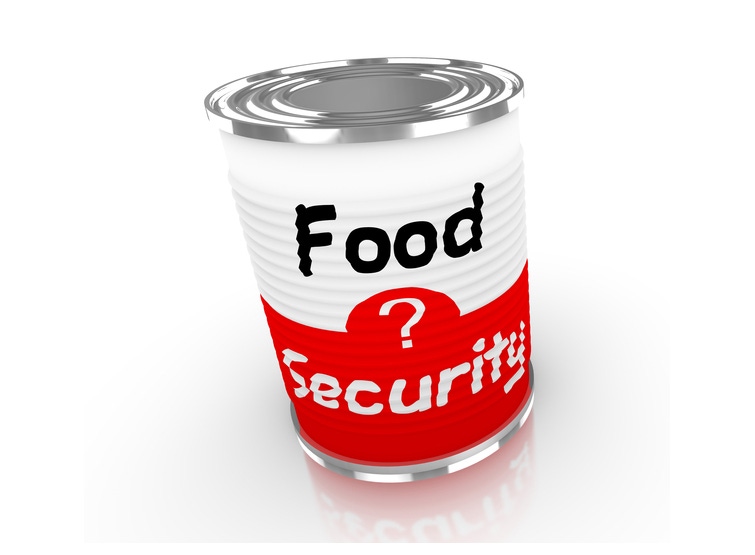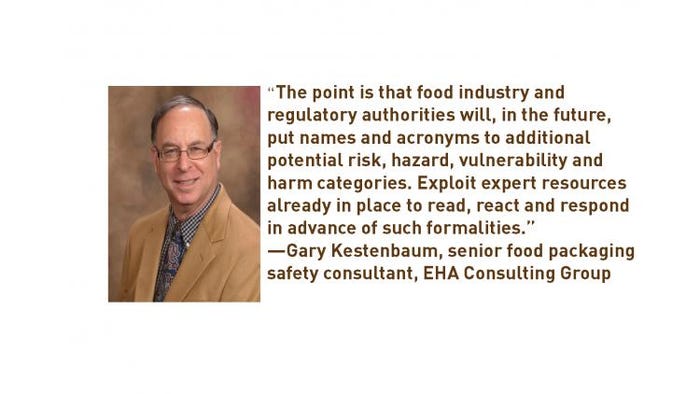Securing your plant against packaged food fraud and related risks
June 1, 2017

Is your facility prepared to assess all food safety and supply chain vulnerabilities? Packaging Safety expert Gary Kestenbaum offers advice on how to adequately address food fraud, adulteration, defense and other risk categories using existing resources.
Last month the column focused on the risk potential for misidentification of raw materials, intermediate products and finished goods (How to avoid mislabeling of packaged foods). A related subject, Food Fraud, is the focus of an initiative and curriculum at Michigan State University and throughout the food industry.
While I understand that Food Fraud (intentional adulteration, deception, tampering) is a specific subject within regulatory and safety program/scheme documents and manuals, the urgency to assess and mitigate risks (for fraud) stems from the objective to identify and control unsuitable, harmful, violative and misrepresented goods in the food industry. Whether these are edible ingredients or non-comestible accessories, the objective of regulatory agencies, oversight organizations and quality control professionals is to continue to control risk through awareness, intervention and proactive action.
As Food Safety Modernization Act (FSMA) rules and global food industry safety oversight guidance and expectations evolve and expand, it should be clear to all in the food supply chain that “end-to-end” safety awareness and control includes risk and harm caused by intentional and unintended consequences. The theory is that both of those need to properly considered, identified and mitigated.
Regulatory rules and private food safety programs require organizations to address multiple categories of unsuitability under various subject headings, as the process of understanding, identifying and controlling all risks are closely related.
Understanding and classifying unsuitable products
There are multiple types of unsuitability which may render a product harmful. Naturally, just because an item is unsuitable for use or distribution does not necessarily make it harmful or violative. More so, the litmus test used to demonstrate adequacy of the safety process within any quality and safety organization involves the ability to consistently find and control all types of unsuitable products including:
Mislabeled/misidentified goods;
Unlabeled goods;
Adulterated goods ;
Fraudulent/misrepresented intermediates or components;
Counterfeit goods;
Violative goods;
Tampered goods;
Damaged goods;
Substandard quality goods which fail to meet minimum standards; and
Unreadable graphics on goods or intermediates.
From a food safety standpoint, defects created within these categories are viewed similarly to those in the food (edibles) production chain. If one step is weak or prone to failure, the entire downstream process and users are exposed to risk and harm.

Create a trained risk assessment team to address comparable objectives
Similar to the process described last month, the cross-functional risk and hazard assessment team is selected, trained and ultimately experienced in the process of analyzing the potential for hazards and harm which would compromise the safety and integrity of the food and food materials supply chain. Why not exploit those resources to look under more “rocks”? Task one team with executing multiple versions of the same process.
Clarify objectives and procedures
Presume that the food facility has or is creating a Hazard Analysis and Critical Control Point (HACCP) or Hazard Analysis and Risk-Based Preventive Controls (HARPC) team to consider risk and hazards, then presume also that the team is or will be trained in the objectives, precepts and procedures to assess and create HACCP and HARPC plans. Expand training of that same team to understand and attack additional risk categories beginning with risks of procurement, purchasing and ordering incoming goods that may be unsuitable, harmful or tainted, then apply the same analysis to risks for goods that have already been trade released.
Eventually, the Assessment Team will perform all risk assessment-related exercises using standardized processes, procedures and document templates as per their training by expert instructors. In the end, the Team objective is to use their training and expertise to develop unique content within standardized formats for understanding, evaluating and mitigating risk and vulnerabilities which may result in the distribution of harmful or unsuitable goods.
Final thoughts
The vision is that in addition to a collection of HACCP or HARPC plans to govern production and related functions, each facility will also have vulnerability analysis (VACCP) plans, fraud assessment (TACCP) plans, Food Defense (intentional sabotage), etc.
The two concepts of this column are process-related. Assume that regulatory authorities and global private trade-specific organizations will issue formal requirements for assessing and mitigating risks within and to the food supply chain.Also assume that each risk or vulnerability category will be matched with an acronym or abbreviation, because, well, we humans love acronyms. The vulnerabilities are not likely to change categorically, so why not get out in front of the process and create the plan?
In doing so, your organization is doing more with less, exploiting trained resources to do what they are ultimately going to have to do anyway. Long before the naming of VACCP or TACCP, food operations and safety professional knew that manufactured or distributed products were exposed to risk categories outside the boundaries of HACCP.
I once mentioned to a category quality manager that there were serious risks to the supply chain related to various aspects of certifying, verifying, testing, specifying, buying, using and warehousing certain kosher raw materials. I knew that the risks were not specifically food safety related, but, rather, risks relating to recall and brand reliability. Right away, I was told, “that’s not HACCP!” which was true, because no one was going to die eating a non-kosher grape flavor. But there certainly were risks of labeling errors or omissions that would cause a trade released product to be legally categorized as misidentified or adulterated, issues addressed in last month’s column.
The point is that food industry and regulatory authorities will, in the future, put names and acronyms to additional potential risk, hazard, vulnerability and harm categories. Exploit expert resources already in place to read, react and respond in advance of such formalities.
Design the team, resource it, train it, create its content, validate the process, implement it and continuously improve it. Your facility will be suitably prepared and resourced to address nearly any contingency!
Gary Kestenbaum has 40 years’ experience in the food and packaging industries, 6 as a supplier with National Starch, 18 as a product developer with General/Kraft Foods and 15 as a packaging engineer and developer with Kraft. As senior food packaging safety consultant with EHA Consulting Group, Kestenbaum provides guidance on packaging safety and suitability-related projects for raw material manufacturers, converters and associated supporting professionals. He can be reached at [email protected] or 410-484-9133. The website is www.ehagroup.com.
About the Author(s)
You May Also Like




